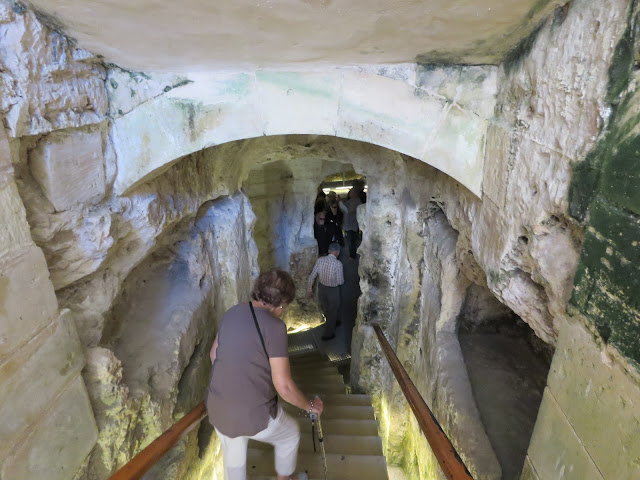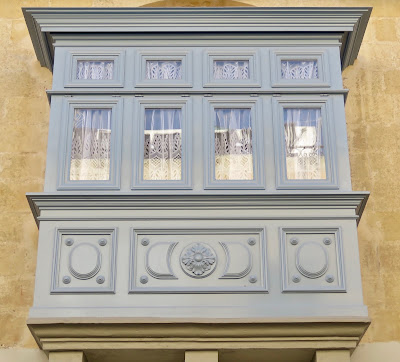Palma de Mallorca, Balearic Islands, Spain
Monday, 20 November 2017
I have finally caught up with the last full day of the cruise as we sail into the wide harbor of Palma de Mallorca on a bright Monday morning. The immense "Cathedral of the Sea," as it is called, can be seen from a distance quite far from the shore. It's a long walk up several flights of outdoor stone steps to reach the front facade, and an even farther walk around the corner to reach the ticket office and entrance.
The exuberant interior is well worth the climb and the expense. Although the overall structure is decidedly Catalan baroque, the interior decoration is modern (early 20th-century) and flamboyant, including a high altar designed and decorated by Gaudi and a side chapel designed by his most prominent follower, Barcelo.

Back on board the Marina we celebrate Will's birthday with glasses of champagne, an excellent dinner, and a birthday cake (hidden by the wine glass) and birthday serenade by the serving staff.
And one last view of the cathedral as pull away from the port at 6pm--a great way to end the last day of a wonderful cruise.
Monday, 20 November 2017
I have finally caught up with the last full day of the cruise as we sail into the wide harbor of Palma de Mallorca on a bright Monday morning. The immense "Cathedral of the Sea," as it is called, can be seen from a distance quite far from the shore. It's a long walk up several flights of outdoor stone steps to reach the front facade, and an even farther walk around the corner to reach the ticket office and entrance.
 |
| Cathedral Garden (modelled on Seville's Alcazar) |
The exuberant interior is well worth the climb and the expense. Although the overall structure is decidedly Catalan baroque, the interior decoration is modern (early 20th-century) and flamboyant, including a high altar designed and decorated by Gaudi and a side chapel designed by his most prominent follower, Barcelo.
 |
| Gaudi Altar |
 |
| Barcelo Chapel |
Other parts of the cathedral are decorated in more traditional fashion, including the largest rose window in southern Europe:
Our visit to the cathedral, the highlight of Palma, comes when we set out on our own after a long morning tour that takes us outside the city to visit Bellaver Castle (outside visit only) for views over the city and harbor, an artificial pearl factory (a shopping stop, really, that was just a waste of time), and an historic country home, still partly occupied by its long-time resident family.
Bellaver Castle, atop a hill just outside the city, is the only fully remaining circular castle in Europe. Our stop this morning does not include a visit inside, but I was able to tour inside on my previous visit this past spring (tap the link to 9 April 2017, at the bottom of the page, to see a photo). The symmetrical circular galleries that line the two floors of the castle provide ample space for the weapons needed to protect the castle from invaders. And the views from the very top level provide immense perspective. But today we must be satisfied with the views, still very nice, from outside the castle.
We then enjoy/endure a 45-minute bus ride into the surrounding countryside, pleasant rural agricultural areas interspersed with large factories and office centers, before reaching the "Pearl Museum." The guided visit to watch bored workers packing artificial pearls into small gift boxes takes about five minutes; afterward, the group is led into an immense showroom and given 45 minutes to wander through long aisles with case after case of jewelry and watches at a variety of prices. Not interested in the sales pitches, Anita, Will, and I head straight to the cafe area we enjoy cappuccinos that are both the tastiest (including the ones fashioned by the baristas on the Marina) and at 1 euro 10 cents--$1.20--the cheapest (except for the free ones on board the Marina) of the whole two-week cruise!

After this visit--actually the first shore excursion on the whole trip that was less than satisfactory--we head for the final, and finally most interesting, part of the tour: a visit to the private estate of El Calderers, in the farming village of Sant Joan (Catalan for St John). The main building dates from 1750 and our guide provides a wealth of detail as she takes us through all of the public rooms on the first level, several private bedrooms on the second level, and parts of the working granary and brewery.
We also have a chance to visit the gardens and see some of the lovely animals in their corrals and nearby fields.
 |
| As the Sheep Turn Their "Backs" to the Camera |
 |
| Gray Pig Used for Prized Local Sausage |
Back on board the Marina we celebrate Will's birthday with glasses of champagne, an excellent dinner, and a birthday cake (hidden by the wine glass) and birthday serenade by the serving staff.




















__03.jpg)








































